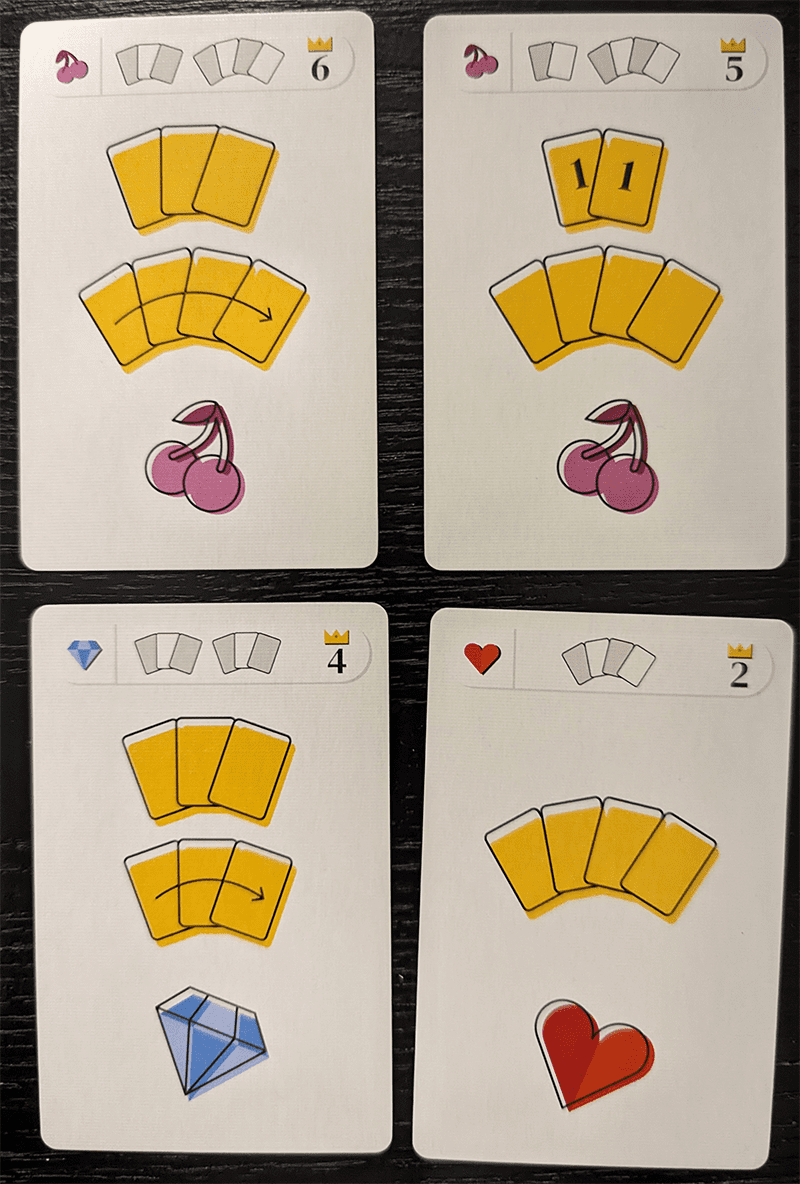In the world of card games, few have captured my heart and mind as thoroughly as Rummy.
Despite my lack of expertise in the game, there’s an inexplicable primal joy that arises within me when I manage to meld cards into sets and runs. There’s something undeniably captivating about the simplicity of the game combined with the numerous strategic possibilities it offers.
Romi Rami is a modern take on the classic game of Rummy. It’s designed to capture all the nostalgia and enjoyment of the original game while introducing a few new twists to keep things fresh and interesting. The rules are also so easy to learn that almost anyone can get into this within a few minutes. In fact, I can probably explain it in four paragraphs.

Obligatory Game Explanation
To begin the game, each player is dealt a hand of three cards from a deck comprising four suits with numbers ranging from 1 to 5. Your turn begins by selecting up to three cards from the face-up market, which consists of six cards. However, you must choose cards that share a common element, be it a suit or a number.
After selecting your cards, the next step is to briefly examine the four face-up contract cards. These contracts specify the conditions needed to fulfill them, such as forming a set of three cards of the same kind or creating a sequence of five cards. If you successfully complete a contract, you can claim the corresponding contract card and discard the cards used to fulfill it, with the exception of cards that offer a suit bonus tied to the contract. You also have a “joker star” that you can use once per game that acts like a wild.
These suit bonus cards grant you additional points at the end of the game. For instance, let’s say you used six cards to fulfill a contract, and the bonus suit associated with it was Hearts. In this case, each Heart card employed to complete that specific contract would earn you an extra point.
Once a player completes a certain number of contract cards, the game will reach its conclusion after everyone has taken the same number of turns. Players will then add their scores from the contracts and the suit bonuses. There are also bonuses for having the majority of particular contracts, such as most hearts or most four-card contracts. The highest score wins.

What’s Old Is New, and New is Old
Now, I am not going to claim this is the most original game or even the cleverest Rummy variant out there. That accolade belongs to Scout. What it does well is offer an alternative card game for families that enjoy Uno or Phase 10 without stuffing their faces with the “joys” of hobbyist game design. This is a game that I can introduce to normal, well-adjusted human beings.
An easy sign of this is the complete lack of downtime. All you are doing on your turn is picking up to three cards from a face-up market and filling as many contracts as you can with your hand. You do have a hand limit of ten cards, which is more than enough to complete something. Turns should last no more than a minute, and if they do, you have my permission to throw pens at the person who is taking this way too seriously.
Perhaps the biggest hook for me is the utilization of these contract cards. Games where players race to claim an objective card to score points are hardly a new concept, as we have seen plenty of games like Century Spice Road take advantage of this. Romi Rami adds a spin to this tradition by having variance with these contract cards through the use of bonus suits.
For instance, let’s say you see a contract card that you can fill within a turn or two. It’s worth 4 points, but the bonus suit is Clover. With your current hand, that’s an extra 3 points, meaning almost double the value of the contract. You might be the only one who can take advantage of this. However, this doesn’t necessarily mean other players won’t take it from you. They might be behind and need to catch up, or perhaps one of the end-game bonuses involves that Clover suit. Throughout its 30-minute duration, Romi Rami masterfully manipulates every player’s moves, pulling their strings in precisely the right directions.

Worth Shuffling The Cards
Indeed, Romi Rami’s gameplay does give rise to a rather clichéd form of player interaction, often involving the classic “you got it before I did” scenario, whether it’s securing the contract first or grabbing the ideal cards from the face-up market. While this feature may not be my personal favorite, I find myself willing to overlook it given the game’s numerous other strengths and its overall exceptional experience, raising the question of whether it’s merely a superficial concern to address.
All in all, Romi Rami has deeply resonated with me, earning a special place in my gaming collection. I wholeheartedly recommend it to anyone seeking a delightful and engaging card game, perfectly balanced with a satisfying level of challenge. Its charming appeal makes it a game that can easily find a home on grandma’s shelf or become a beloved addition to a cottage getaway, thanks to its compact box and inviting table presence.
While some might dismiss it for not being the most groundbreaking or original game, I embrace its simplicity and accessibility. Not every game needs to be an intellectual puzzle to be thoroughly enjoyable. Romi Rami’s ability to deliver pure fun and entertainment without putting my brain into a chokehold is something I’m thankful for.












Add Comment